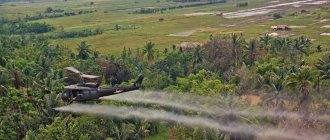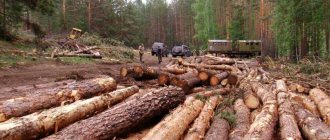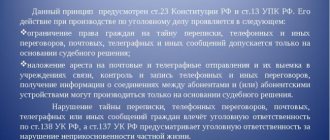During military operations to protect the environment, liability for such an atrocity as ecocide was introduced in world legal practice. This was due to the fact that during wars heavy damage was caused to the environment, causing the ecology of a particular area to suffer greatly.
After which ecocide received its legal recognition in international legal acts (Conventions, international covenants and treaties). This concept refers to actions involving large-scale destruction of flora and fauna, poisoning of atmospheric air and water bodies, and other actions that entail a change in the environmental situation in the region.
The actions of the perpetrators are aimed at eliminating or attempting to destroy the natural environment for human life. This concept first appeared in domestic legislation in 1997, when an article for genocide was introduced in the Criminal Code of the Russian Federation. The concept, types of legal liability, examples from judicial practice on ecocide, the elements of an international crime and types are presented in this article.
General information about ecocide
This crime is particularly serious in terms of severity, since it causes irreparable damage to the environment, and refers to criminal actions aimed against the peaceful and safe existence of people. Ecocide stands alongside equally dangerous crimes such as genocide, the proliferation of weapons of mass destruction, the use of illegal means of warfare, calls for participation in armed conflicts, and others.
Concept and legal norms
In Art. 358 of the Criminal Code of the Russian Federation defines the crime of ecocide. It constitutes the commission of the following illegal actions:
- mass destruction of flora and fauna;
- poisoning of atmospheric air and water sources;
- other actions that may lead to environmental disaster.
Object of encroachment
From the definition, three objects of encroachment can be distinguished:
- Tribal – relationships that ensure the safety of human life (the entire natural habitat of all living things).
- Species – relationships that ensure the environmental safety of human life.
- Direct - relationships that ensure the protection of humanity from specific dangers of an environmental nature (specific elements of nature - water, airspace, flora and fauna).
Public danger
The public danger from crime is expressed in damage to the natural living conditions of humans and all life on the planet, a stable basis for the socio-economic development of states, as well as the existing gene pool of nationalities, nations, flora and fauna. However, the definition of the main categories associated with this criminal act must be sought in other legal sources. Without special terminology, it is impossible to fully disclose the composition of ecocide.
- Large-scale destruction of flora and fauna - actions aimed at stopping the vital activity of one species or the entire set of forms of representatives of living beings and plants (complete or partial elimination).
- Poisoning of atmospheric air and water sources - actions to spread toxic and harmful substances (of chemical, biological and radioactive origin) in the atmosphere, as well as in water bodies, resulting in negative consequences for all life on the planet.
- Other activities of human activity may be associated with the production, research, experimental process of people, as a result of which preconditions arise for the onset of an environmental disaster or catastrophe.
- An environmental disaster (catastrophe) is a serious consequence for the environment that entails irreversible and dangerous changes that are significant for all living beings (a breakdown in the ecological balance in nature occurs).
Terms used
- Flora is a collection of plants growing on the territory of one state or a single area, which are interconnected depending on growing conditions.
- Fauna is a collection of species of representatives of the wild animal world that are in a free state, living in a specific area or throughout the entire country.
- Atmospheric air is the air space above the Earth’s surface, which consists of various chemical components (oxygen, nitrogen and others).
- Water resource – water sources located on the surface and underground, forming a water body, which can be used by humans for their own purposes.
Composition of a criminal act and qualification features
The totality of illegal actions included in ecocide form its objective side. It consists of three alternative actions above. Also, one of the components of the objective side is the cause-and-effect relationship, i.e. actions must lead to the onset of consequences determined in the norm - an environmental disaster.
The composition of a criminal act is formal and material. To qualify certain acts as ecocide, certain consequences must occur, which are expressed in:
- the onset of an environmental disaster;
- the cessation of the existence of certain species of flora and fauna;
- changes in the quality and composition of the atmosphere due to saturation with dangerous emissions, etc.
In addition to the occurrence of specific serious consequences for the environment, the crime can also be considered completed from the moment a real danger of the occurrence of the above results appears.
The subjective side is characterized by:
- direct intention (the perpetrator is aware of the danger of his actions and seeks to cause damage to the environment);
- indirect intention (the subject consciously allows harm to be caused to the environment or has an indifferent attitude towards the occurrence of consequences).
The subject of committing criminal acts is a general one; this can be any citizen or group of persons, regardless of their social status or position. Also, the guilty party may be a special subject: an official in the public service, as well as having military status. Age limit is 16 years. The elements of the crime do not have qualified types.
Distinction from adjacent compounds
Environmental
The closest crimes on the subject are environmental compounds, which are placed in a separate section of the Criminal Code. This category is special in relation to ecocide. Such criminal acts include:
- water pollution;
- damage to the earth;
- illegal hunting;
- actions to pollute the atmospheric air and marine environment;
- violation of the special regime established for specially protected objects of flora and fauna.
The content of these elements of atrocities is clearly environmental. Considering the object of environmental crimes, there are two types of criminal acts that encroach on:
- Environmental law and order in general. Object - legal relations related to the environment, combined into a single object of legal regulation.
- The legal order established for the protection and use of individual natural objects.
Special
In addition to purely environmental crimes, the Criminal Code provides for related compounds that perform environmental tasks only under special circumstances. Among these compositions:
- refusal to provide citizens with information;
- actions for illegal registration of transactions with land plots;
- acts of terrorism;
- illegal handling of radioactive materials;
- violation of safety rules when using dangerous and harmful substances, products, etc.
These atrocities acquire environmental meaning only when illegal actions are committed that entail a violation of the order of environmental management and, as a result, cause damage to the environment.
Ecocide is a crime against public health, and how it relates to genocide, read below.
Genocide
One of the most dangerous crimes is genocide, which has a similar object of attack to ecocide - the safe existence of all humanity. However, it has different qualifications on the objective side, which is expressed in criminal actions against humanity (destruction of human groups, causing serious harm to health, creating unacceptable conditions for existence).
Thus, the main distinction occurs based on specific criminal actions that have similar consequences - the destruction of life on Earth, be it a person, be it a representative of the animal or plant world. Read below about what ecocide as an environmental crime entails liability.
International law
Since the 1970s, governments, businesses and communities have increasingly supported reforming the Rome Statute and making ecocide a fifth crime against peace. [3] It is part of an emerging body of law known as "Terrestrial Jurisprudence". [ 4 ]
Proponents of recognizing ecocide as an environmental crime and an international crime argue that this must be done to protect human rights and the environment. However, some of its opponents argue that it will lead to the criminalization of all humanity [ 5 ] - a pretext that is inconsistent with international criminal law, since it only prosecutes those responsible for crimes.
Punishment and responsibility
Some legal scholars believe that unreasonably low sanctions are provided for this crime. Thus, the norm establishes a non-alternative punishment - imprisonment.
However, the sentence may vary depending on the circumstances of the criminal acts, the identity of the accused and other provisions - from 12 to 20 years. The severity and high danger of this crime requires the establishment of a more serious punishment, up to life imprisonment.
References
- Cunningham (1998). Environmental Encyclopedia (English) (2nd edition). Detroit: Gale. ISBN 0-8103-9314-X.
- J. William Schopf. "Palaeobiology of the Precambrian: The Age of Blue-Green Algae". Evolutionary Biology
. Springer. ISBN 978-1-4615-6946-6. - Goger, Anya (2012). Ecocide is the missing 5th crime against peace. University of London. ISBN 9780957521056.
- “History of earthly jurisprudence” (undefined). Gaiafoundation.org. Archived from the original on August 19, 2014. Retrieved August 15, 2014
- Posel, Suzanne (2012). Ecocide: The Push to Criminalize Humanity to Save the Planet. RiseEarth
(in English). Archived from the original on May 28, 2015. - "Damage the environment with war crimes, scientists say". Guardian
(in English). July 24, 2022. Retrieved March 22, 2021. - ^ a b
"Children of Agent Orange".
Cordoba Journal
. October 7, 2004. Retrieved June 2, 2022. - Broswimmer, Franz J. (2006). Ecocide. A Brief History of Mass Extinctions. Mexico City: ocean. paragraph 96. ISBN 978-970-777-132-1. OCLC 150377456. Retrieved August 15, 2022.
- ↑ a b
Jimenez, Natalia (2007). "Ecocide". Reviewed 2007. - Knight, Daniel (2007). Coca control threatens the Amazon
. |fechaacceso=required |url=(help)
Arbitrage practice
Since the appearance of the norm in the Criminal Code, little judicial practice has been developed on ecocide in the Russian Federation. However, in law enforcement practice there are cases of large-scale destruction of flora and fauna. One such case is a sensational investigation in early 2002. A high-profile incident occurred in the Kamchatka Territory at one of the fishing enterprises, when illegal actions of poisoning salmon fry were recorded.
The crime took place at the end of 2001, when a group of unknown persons poured bleach into a water well. As a result, a couple of million salmon fry were poisoned. Based on this fact, a criminal case was initiated under the article “Ecocide”. During the investigative measures, the damage caused was calculated in the amount of 12 billion rubles.
Ecocide, like genocide and waging aggressive war, is a terrible crime against peace.
Present tense
The processes affecting ecosystems are very varied and very complex, from the simple use of non-biodegradable products in our daily lives to the indiscriminate use of pesticides to kill crop pests, which, paradoxically, are necessary to prolong the life of the ecosystem. human species.
The consequences for wildlife were not long in coming, with estimates that from 1500-1850 one bird species disappeared forever every ten years, then it is concluded that at this rate a species is disappearing every hour since 2000, on Topic, Food and Agriculture An organization known as the FAO states: "70% of the world's major fish stocks are extinct or overexploited, seventeen of the world's largest fisheries have reached or exceeded sustainable limits, and wild species are becoming extinct at a rate of 100%. times faster than natural. Every minute the species is disappearing.” [ link needed
]
As for land resources, contrary to what the economists of the school of economic thought known as the Physiocrats and its main representative Francis Quesnay believed, land cannot currently be considered as an unlimited good; on the contrary, in the desire to increase land productivity, erosion processes increase due to the need for more resources to produce food, once the land becomes barren, there is a need to increase the agricultural frontier with its environmental consequences such as the destruction of forests and everything else, the ecocide that this brings. “There are fewer forests every day. Every year, about 2,300 km² of fertile land becomes desert. Another 77,500 km² are destroyed or severely depleted. A quarter of the earth's surface is threatened by irreversible desertification, largely due to agricultural activities themselves. The land is also polluted by the excessive use of artificial fertilizers and phytosanitary products (insecticides, herbicides, fungicides, etc.)” [10]
In the context of globalization, production processes are standardized, land and air pollution leads to the fact that its consequences are manifested throughout the planet, global warming.









